



|
|

|

|
| The SATCO 700 Semi-Auto |
| The whatnow, you ask? I'm not surprised you've never
heard of it... or if you've heard of it, you've never seen one. It's the SATCO 700, a rare, limited-edition semiautomatic paintball gun, made around 1995 or so, by a company called Sport Arms Technology Company, or SATCO, out of Texas. This particular example is stamped #028, with the matching, fitted carrying case, and is marked "One of Seven Hundred". I have no idea if all 700 were actually produced, though I'd wager not, simply since I've read exactly one single reference to the gun since '95, and have never run across another, or even been asked about one, since and until now. |
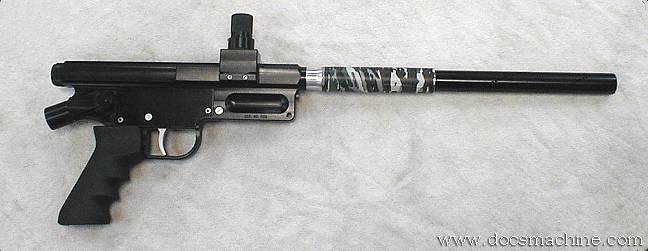
|
| So what happened to it? Who knows... However, it was
probably a combination of factors; First off, it's terribly complex, which
we'll dig into further in a moment. Second, due to it's quality and complexity,
it was rather expensive- I seem to recall it was retailing at roughly $700,
back in '95. Third, I suspect that it wasn't terribly reliable. In investigating
this example, which is nearly brand-new, I've already run across some cycling
problems and maintainence headaches. |

|
| The carrying case is well made, and though not quite
Gucci quality, it's quite rugged. The foam is fitted almost perfectly to
the gun, and there's room for the VL100 loader, a 12-ounce tank with buttplate,
two nut-driver type tools for working on the gun, a bottle of KC Troublefree
synthetic oil, and.... |

|
| ... An interesting add-on vertical adapter with a
hollow, dummy foregrip "can" (though no additional plumbing to connect it
to the gun's back-bottle ASA) and what looks like an early Smart Parts "All
American" barrel that's been remachined to fit the SATCO's barrel threading. |

|
| Here you can see what is presumably the developer/inventor's
signature, machined into the side of the gun, along with "SATCO 700" and
"Sport Arms Technology Company" and the usual "this is not a toy" disclaimer.
I have no idea who "RA Williams" is, perhaps someone remembers the fellow
and can fill us in on the details. |

|
| Getting into the details, have a look at the above
photo. The large circular device towards the back is one side of a built-in
pressure regulator, mounted sideways in the body of the gun. The smaller
circular object is the sear pivot pin (yes, they built it very stout) and
just below that is the white manual safety button. Also note the "vertical"
side feed. |
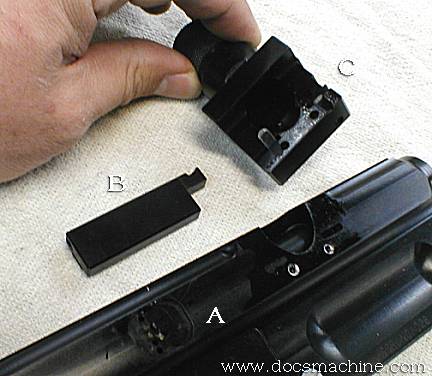
|
| Taking off the "vertical" sidefeed block, we see an
interesting clear-plastic springloaded ball detent, a clever design. After poking around a bit, we're offered this surprise- there's a built-in "air assist" system! Just like the Shocker setups that have a hose and a little port that puffs some air into the feed neck to help chamber the next ball, this system has an interesting set of finely-machined bits that all link together to route air from the chamber ports (to the left of "A") through the hollow block "B"- which has a clever grooved lock to hold it in place- and up into the corner of the feed neck block (just to the left of the "C") where it runs through some internal passages to three angled ports right inside the neck itself. Convoluted, and of dubious value, but a clever assemblage to be sure. |
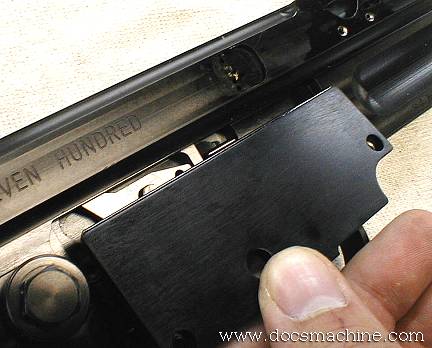
|
| Moving on to the side panel which covers the trigger
mechanism, we find yet another trick- the cover is grooved at the top to
very precisely and rigidly lock itself into place. |
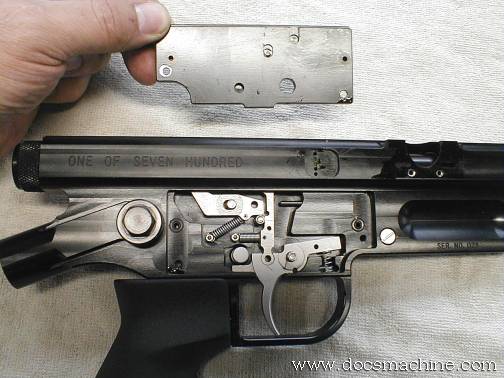
|
| Not only is the side cover grooved to lock into place,
but it's also rather thick, fitted to help support the sear and trigger pins
when in place, and most interesting of all, the air passage that connects
the regulator at the back of the gun, to the front, passes through the side
cover itself! |
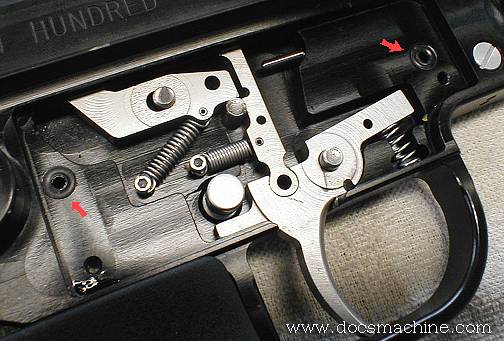
|
| In this close-up, the red arrows point to the two
O-rings that seal the air passage going through the side cover. The three trigger pieces appear to be stainless steel, and quite intricately machined. Some clever bits here- note the small black thing just below the trigger pivot; that's a small nylon or delrin rod that helps reduce friction as the trigger is pulled. Personally, I like how the trigger and the center link-bar are joined with a relatively large-radius pivot point- the trigger is actually very smooth in operation. When the gun is cocked, the center bar pushes up on the sear rocker at the top, much like most normal blowbacks... The interesting thing here is, that the center link is driven by the forward-moving bolt/hammer, to strike the small rod you see sticking out of the reciever just above the trigger pivot. So that sear linkage is in fact itself also a "sub-hammer"... |
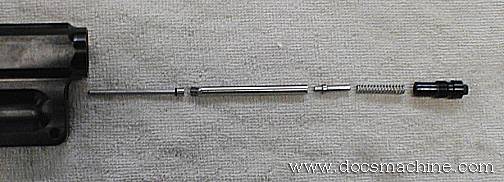
|
| That rod is shown above, removed. Sure doesn't look
like a normal cup seal and valve, does it? That's because it's not. The above mechanism is a "cup seal" and valve of a sort, but all it does is provide a small shot of air which recocks the hammer/bolt assembly. It is not the "firing" valve mechanism. |

|
| And finally, the bolt/hammer itself! This is the heart of the beast: twenty-nine individual pieces, exquisite craftsmanship, and I'm not entirely sure just exactly how it works. First off, and most interesting, is that there's no mainspring. In the usual blowback, the hammer is driven forward by spring pressure- in this marker, there is no such thing. Presumably the long central rod acts as a ram in the brass sleeve at the back... though the rod has no piston O-ring as one would expect from a ram. When the sear is released, the air pressure forces the front section forward as if on a spring. After a certain distance of travel, the rod stops, but the front bolt sleeve and hammer-collar continue forward for a bit, the inertia of which is stopped by the top-hat shaped poppet at the lower right in the photo. This is retained by a split collar... |
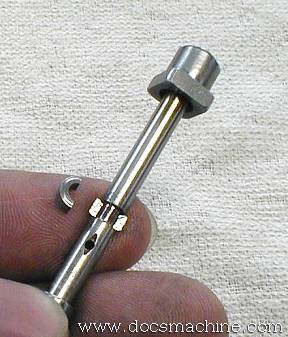
|
| ... Which allows the seal on the end of the rod to
open, releasing a blast of air out the front of the bolt. Note as shown above,
that air is routed down the middle of the rod. |

|
| The assembly as a whole has seven active O-rings and
one urethane seal, but it seems to work, and works pretty well. Reliability
seems to be an issue, and I'd worry about the long-term use and wear, myself,
but from a purely tinker-freak aspect, it's terribly cool. As mentioned above, the sear-linkage acts as a hammer to strike the miniature cup seal, which provides the blowback/recock air... |

|
| ... Plus, there's this clever little button here,
that manually releases a burst of recock air. That's right, to cock the gun,
whether first thing when gassing up or to reset after a misfire, you just
push this little button. There is no other external knob, rod or slot with
which to cock the gun. |

|
| All of the above is supplied with air from the gun's
own unique transverse-mounted, built-in pressure regulator. Here you can
see the left-side cover has been removed, showing the four massive Belleville
spring washers, the adjuster screw, and the inner and outer spring-pack caps.
Pressure, and thus velocity, is adjusted with the small center setscrew. |
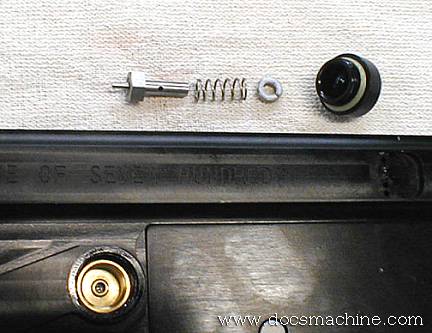
|
| Opposite that is a smaller cap on the right side,
that covers the regs' primary seal and spring. The brass seat/body assembly
is removable from the receiver. Air exits this side of the reg and enters
the cross-body air channel, as well as being routed upwards to the bolt feed
assemblies. There's almost a full dozen small passages drilled throughout
the gun at various angles and locations, most capped with tiny setscrews,
some with screws machined to accept O-rings. |

|
| They couldn't even leave the backbottle ASA alone.
Instead of a standard machined tank adapter, this one has this steel depressor-pin
insert, sealed- I have no idea why- with an O-ring and retained by a small
circlip-type snap ring. So how's it work? Not to badly, in fact. This gun had apparently been sitting for a while by the time I set upon it, though fortunately, the high-quality KC synthetic oil, unlike conventional oils, had not dried out or gummed up. It's good stuff, I use it myself. The front bolt O-ring had all but crumbled, however, and I eventually replaced it with a black rubber replacement. A tank O-ring looks like it'd be a perfect fit, but for some reason gave erratic recocking symptoms. In the course of my investigations, I wiped off a bit of gunk here and there, nothing much, and made sure everything had a drop of oil or two. The gun's remarkably clean, and appears to have had minimal, if any, actual use. Seals and O-rings are clean and damage-free, the anodizing is cherry and no internals show the least bit of wear. One of the original reviews of the gun way back when, in PCRI, joked that "SATCO 700" referred to the number of parts the gun contained... There's not quite seven hundred parts, but the gun does indeed have two or three times more individual components than many of the more recent semiautos... In fact, I think the only gun that might have more pieces would be the chain-fed AT-85 select-fire marker. The SATCO bolt alone has more individual parts than an entire standard Spyder blowback marker. After the disassembly/inspection/reassembly, the gun worked and worked well. The trigger is short, crisp and very good. An excellent trigger for a blowback, actually- no mush or excessive overtravel, no creep and a nice 'snap'. It's a bit stiff, which limits the maximum ROF you'll achive, but it's hardly a problem. In testing I used some old Diablo I had sitting around, and it proved to be quite accurate and surprisingly quiet. However, being an already-rare brand, and complete with the fitted case with matching serial-number plate, this one should be a collector's piece, not a user. If we could just find an owner's manual for it, we'd be set. |
All text, photos and graphics Copyright
1998- 2015, Doc's Machine & Airsmith Services. All Rights Reserved.
Information contained in these
pages is for reference and entertainment purposes only. Our methods
are not always the best,
quickest, safest, or even the correct ones. It's up to you to know how to
use your own machines and tools.
Keep your fingers away from the spinny blades o' death and you should be
all right.